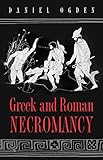Greek and Roman Necromancy / Daniel Ogden.
Material type: TextPublisher: Princeton, NJ : Princeton University Press, [2019]Copyright date: ©2002Description: 1 online resource : 13 halftones. 3 line illusContent type:
TextPublisher: Princeton, NJ : Princeton University Press, [2019]Copyright date: ©2002Description: 1 online resource : 13 halftones. 3 line illusContent type: - 9780691009049
- 9780691207063
- 133.9/0938 22
- BF1591 .O33 2001eb
- online - DeGruyter
- Issued also in print.
| Item type | Current library | Call number | URL | Status | Notes | Barcode | |
|---|---|---|---|---|---|---|---|
 eBook
eBook
|
Biblioteca "Angelicum" Pont. Univ. S.Tommaso d'Aquino Nuvola online | online - DeGruyter (Browse shelf(Opens below)) | Online access | Not for loan (Accesso limitato) | Accesso per gli utenti autorizzati / Access for authorized users | (dgr)9780691207063 |
Browsing Biblioteca "Angelicum" Pont. Univ. S.Tommaso d'Aquino shelves, Shelving location: Nuvola online Close shelf browser (Hides shelf browser)

|

|

|

|

|

|

|
||
| online - DeGruyter Abbot Suger on the Abbey Church of St. Denis and Its Art Treasures : Second Edition / | online - DeGruyter God's Long Summer : Stories of Faith and Civil Rights / | online - DeGruyter Affordable Housing in New York : The People, Places, and Policies That Transformed a City / | online - DeGruyter Greek and Roman Necromancy / | online - DeGruyter The Rebellion of the Daughters : Jewish Women Runaways in Habsburg Galicia / | online - DeGruyter An Intellectual History of Liberalism / | online - DeGruyter Hindu Rulers, Muslim Subjects : Islam, Rights, and the History of Kashmir / |
Frontmatter -- CONTENTS -- LIST OF FIGURES -- PREFACE -- ABBREVIATIONS -- INTRODUCTION -- PART I: PLACES -- CHAPTER 1. TOMBS AND BATTLEFIELDS -- CHAPTER 2. ORACLES OF THE DEAD -- CHAPTER 3. THE HERACLEIA PONTICA AND TAINARON NEKUOMANTEIA -- CHAPTER 4. THE ACHERON NEKUOMANTEION -- CHAPTER 5. THE AVERNUS NEKUOMANTEION -- CHAPTER 6. INCUBATION AND DREAMING -- PART II: PEOPLE -- CHAPTER 7. EVOCATORS, SORCERERS, AND VENTRILOQUISTS -- CHAPTER 8. SHAMANS, PYTHAGOREANS, AND ORPHICS -- CHAPTER 9. ALIENS AND WITCHES -- CHAPTER 10. NECROMANCY AMONG THE ROMANS -- PART III: TECHNOLOGY -- CHAPTER 11. TRADITIONAL RITES OF EVOCATION -- CHAPTER 12. FROM BOWL DIVINATION TO BOY-SACRIFICE -- CHAPTER 13. REANIMATION AND TALKING HEADS -- PART IV: THEORY -- CHAPTER 14. GHOSTS IN NECROMANCY -- CHAPTER 15. THE WISDOM OF THE DEAD -- CHAPTER 16. BETWEEN LIFE AND DEATH -- CONCLUSION: ATTITUDES TOWARD NECROMANCY -- BIBLIOGRAPHY -- INDEX
restricted access online access with authorization star
http://purl.org/coar/access_right/c_16ec
In classical antiquity, there was much interest in necromancy--the consultation of the dead for divination. People could seek knowledge from the dead by sleeping on tombs, visiting oracles, and attempting to reanimate corpses and skulls. Ranging over many of the lands in which Greek and Roman civilizations flourished, including Egypt, from the Greek archaic period through the late Roman empire, this book is the first comprehensive survey of the subject ever published in any language. Daniel Ogden surveys the places, performers, and techniques of necromancy as well as the reasons for turning to it. He investigates the cave-based sites of oracles of the dead at Heracleia Pontica and Tainaron, as well as the oracles at the Acheron and Avernus, which probably consisted of lakeside precincts. He argues that the Acheron oracle has been long misidentified, and considers in detail the traditions attached to each site. Readers meet the personnel--real or imagined--of ancient necromancy: ghosts, zombies, the earliest vampires, evocators, sorcerers, shamans, Persian magi, Chaldaeans, Egyptians, Roman emperors, and witches from Circe to Medea. Ogden explains the technologies used to evocate or reanimate the dead and to compel them to disgorge their secrets. He concludes by examining ancient beliefs about ghosts and their wisdom--beliefs that underpinned and justified the practice of necromancy. The first of its kind and filled with information, this volume will be of central importance to those interested in the rapidly expanding, inherently fascinating, and intellectually exciting subjects of ghosts and magic in antiquity.
Issued also in print.
Mode of access: Internet via World Wide Web.
In English.
Description based on online resource; title from PDF title page (publisher's Web site, viewed 29. Feb 2020)


